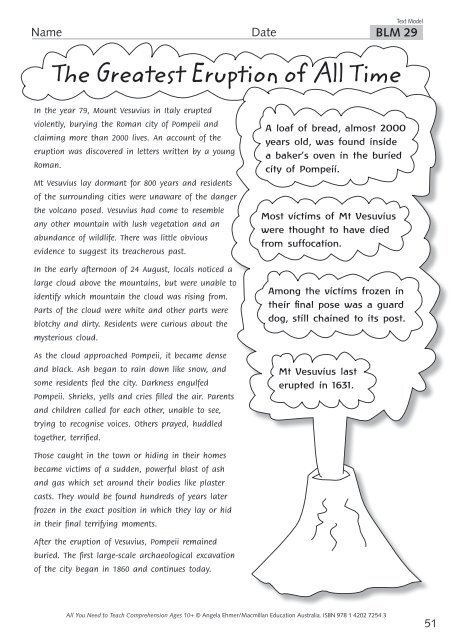All You Need To Teach Comprehension 10+
Create successful ePaper yourself
Turn your PDF publications into a flip-book with our unique Google optimized e-Paper software.
Name<br />
Date<br />
Text Model<br />
BLM 29<br />
The Greatest Eruption of <strong>All</strong> Time<br />
In the year 79, Mount Vesuvius in Italy erupted<br />
violently, burying the Roman city of Pompeii and<br />
claiming more than 2000 lives. An account of the<br />
eruption was discovered in letters written by a young<br />
Roman.<br />
Mt Vesuvius lay dormant for 800 years and residents<br />
of the surrounding cities were unaware of the danger<br />
the volcano posed. Vesuvius had come to resemble<br />
any other mountain with lush vegetation and an<br />
abundance of wildlife. There was little obvious<br />
evidence to suggest its treacherous past.<br />
In the early afternoon of 24 August, locals noticed a<br />
large cloud above the mountains, but were unable to<br />
identify which mountain the cloud was rising from.<br />
Parts of the cloud were white and other parts were<br />
blotchy and dirty. Residents were curious about the<br />
mysterious cloud.<br />
As the cloud approached Pompeii, it became dense<br />
and black. Ash began to rain down like snow, and<br />
some residents fled the city. Darkness engulfed<br />
Pompeii. Shrieks, yells and cries filled the air. Parents<br />
and children called for each other, unable to see,<br />
trying to recognise voices. Others prayed, huddled<br />
together, terrified.<br />
A loaf of bread, almost 2000<br />
years old, was found inside<br />
a baker’s oven in the buried<br />
city of Pompeii.<br />
Most victims of Mt Vesuvius<br />
were thought to have died<br />
from suffocation.<br />
Among the victims frozen in<br />
their final pose was a guard<br />
dog, still chained to its post.<br />
Mt Vesuvius last<br />
erupted in 1631.<br />
Those caught in the town or hiding in their homes<br />
became victims of a sudden, powerful blast of ash<br />
and gas which set around their bodies like plaster<br />
casts. They would be found hundreds of years later<br />
frozen in the exact position in which they lay or hid<br />
in their final terrifying moments.<br />
After the eruption of Vesuvius, Pompeii remained<br />
buried. The first large-scale archaeological excavation<br />
of the city began in 1860 and continues today.<br />
<strong>All</strong> <strong>You</strong> <strong>Need</strong> to <strong>Teach</strong> <strong>Comprehension</strong> Ages <strong>10+</strong> © Angela Ehmer/Macmillan Education Australia. ISBN 978 1 4202 7254 3<br />
51


















